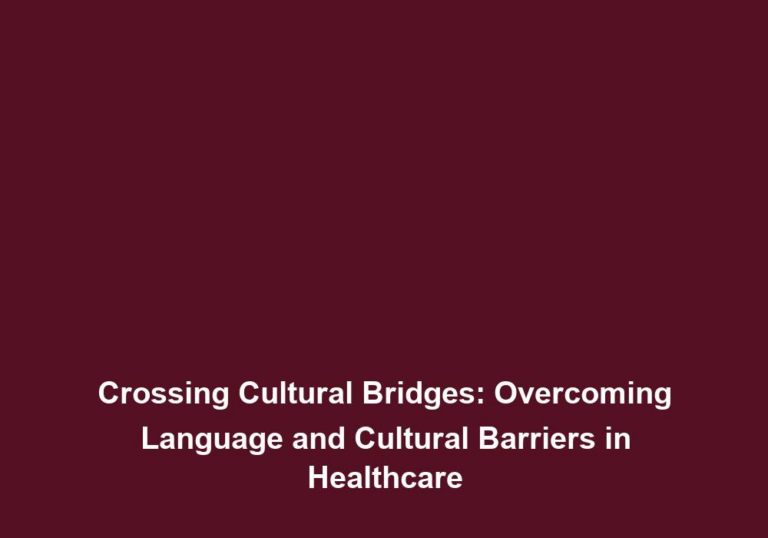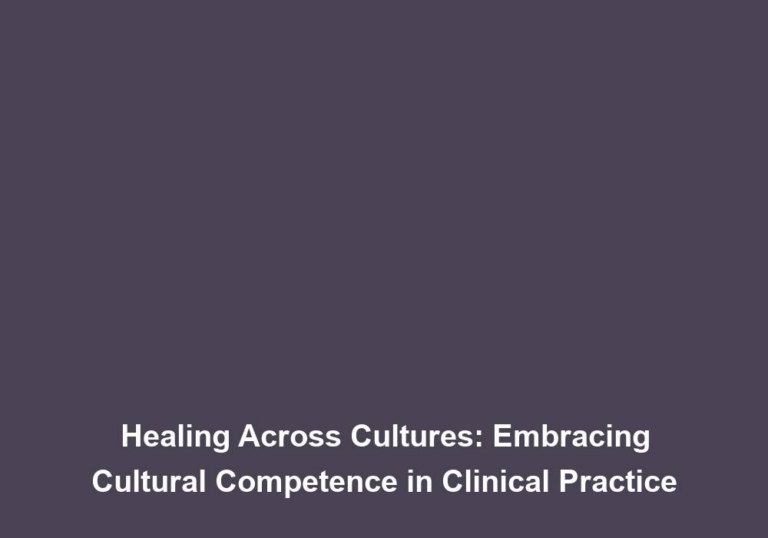Crossing Cultural Bridges: Overcoming Language and Cultural Barriers in Healthcare
The provision of quality healthcare services is an essential aspect of any society, but it becomes even more challenging when language and cultural barriers come into play. These barriers hinder effective communication between healthcare providers and patients, potentially compromising the quality of care and patient outcomes. In order to ensure equitable access to healthcare for all individuals, it is imperative to bridge these gaps and find effective solutions.
Understanding the Language Barrier
Language serves as a means of communication, connecting individuals with one another. However, in a multicultural society, where people from diverse linguistic backgrounds seek healthcare services, the language barrier poses a significant obstacle. When patients cannot effectively express their symptoms, concerns, or medical history due to a language barrier, it becomes difficult for healthcare professionals to accurately diagnose and treat them.
To address this challenge, healthcare providers can implement the following strategies:
-
Professional Interpreters: Engaging professional interpreters who are fluent in both the patient’s language and English can greatly enhance communication between healthcare providers and patients. These interpreters ensure accurate interpretation, maintaining the integrity of the information exchanged. They play a vital role in facilitating effective communication by accurately conveying medical information, ensuring that patients fully understand their diagnosis, treatment options, and any instructions provided by healthcare professionals.
-
Cultural Mediators: In addition to interpreters, cultural mediators can help bridge the cultural gap between healthcare providers and patients. These individuals possess cultural knowledge and understanding, enabling them to explain medical concepts or practices in a culturally appropriate manner. Cultural mediators not only assist in overcoming language barriers but also provide insight into cultural beliefs and practices that may impact healthcare decisions. They help healthcare providers understand the patient’s cultural background, allowing for more personalized and culturally sensitive care.
-
Multilingual Staff: Having multilingual staff within healthcare facilities can also facilitate effective communication. When healthcare providers can communicate directly with patients in their native language, it helps establish a sense of trust and understanding. Multilingual staff members can assist in gathering accurate information from patients, ensuring that nothing is lost in translation. Moreover, they can serve as cultural liaisons, providing patients with a familiar and comfortable environment to express their concerns and preferences.
-
Technology: Advancements in technology have enabled the development of language translation tools and applications. These tools can assist in overcoming language barriers by providing real-time translation during healthcare consultations. With the help of technology, healthcare providers can communicate with patients who speak different languages without the need for an interpreter. This can be especially useful in emergency situations where immediate communication is crucial. However, it is important to note that technology should not replace the need for human interpreters and cultural mediators, as they bring a level of cultural understanding and context that technology may lack.
Navigating Cultural Barriers in Healthcare
Apart from language barriers, cultural differences also play a crucial role in healthcare interactions. Every culture has its own beliefs, values, and practices related to health and illness. These cultural nuances can significantly influence how patients perceive and seek healthcare. It is essential for healthcare providers to be aware of and sensitive to these cultural differences to ensure effective care delivery.
Consider the following strategies to navigate cultural barriers in healthcare:
-
Cultural Competence Training: Healthcare providers should receive cultural competence training to enhance their understanding of different cultures, beliefs, and practices. This training equips them with the necessary skills to provide culturally sensitive care and avoid misunderstandings. Cultural competence training helps healthcare providers become aware of their own biases and assumptions, enabling them to provide individualized care that respects and integrates patients’ cultural values.
-
Respecting Cultural Practices: Cultural practices related to diet, religious beliefs, or traditional medicine may impact a patient’s healthcare decisions. Healthcare providers should respect these practices and involve patients in their care plans, considering cultural preferences and beliefs. By incorporating cultural practices into the treatment plan, healthcare providers can ensure that patients feel valued and respected, leading to better adherence and overall satisfaction with the care received.
-
Creating a Welcoming Environment: Healthcare facilities should strive to create a welcoming environment that reflects cultural diversity. Displaying multicultural artwork, providing reading materials in different languages, and accommodating religious practices can foster a sense of inclusion and comfort for patients from diverse backgrounds. Additionally, healthcare providers can consider incorporating culturally diverse staff members and fostering an inclusive work environment that promotes cultural understanding and sensitivity.
-
Engaging Community Organizations: Collaborating with community organizations that serve specific cultural or ethnic groups can help healthcare providers better understand the needs of these communities. By establishing partnerships, healthcare facilities can develop culturally tailored programs or initiatives to meet the unique healthcare requirements of different populations. Community organizations can provide valuable insights into cultural practices, beliefs, and barriers faced by specific communities, enabling healthcare providers to adapt their services accordingly and provide more targeted and effective care.
By employing these strategies and being proactive in addressing language and cultural barriers, healthcare providers can ensure that all patients receive equitable access to quality healthcare services. Breaking down these barriers not only improves patient satisfaction but also enhances overall healthcare outcomes.
It is important to recognize that overcoming language and cultural barriers is an ongoing process. Healthcare providers must continuously evaluate their practices, learn from patient experiences, and adapt their approaches to provide inclusive care for all individuals, regardless of their linguistic or cultural background.
In conclusion, crossing cultural bridges and overcoming language barriers in healthcare is crucial for improving healthcare outcomes and ensuring equitable access to quality care. By implementing strategies such as professional interpreters, cultural mediators, cultural competence training, and creating a welcoming environment, healthcare providers can foster effective communication and bridge the gap between different cultures. As healthcare continues to evolve, it is essential to prioritize inclusivity and cultural sensitivity to meet the diverse needs of patients from various linguistic and cultural backgrounds.







